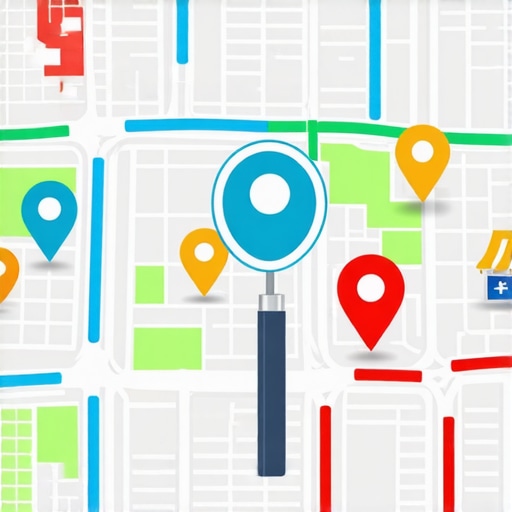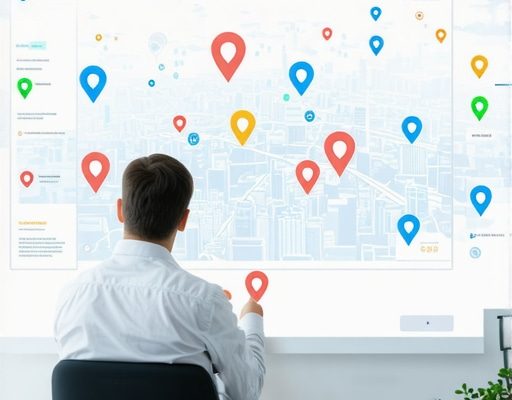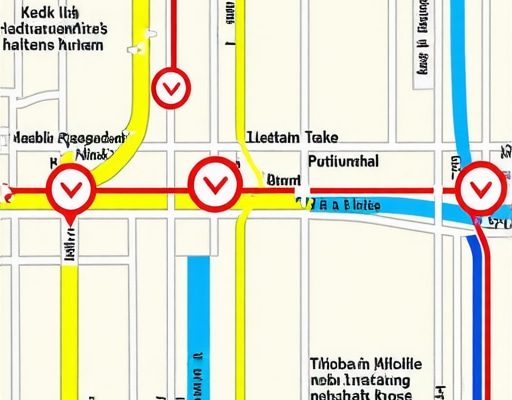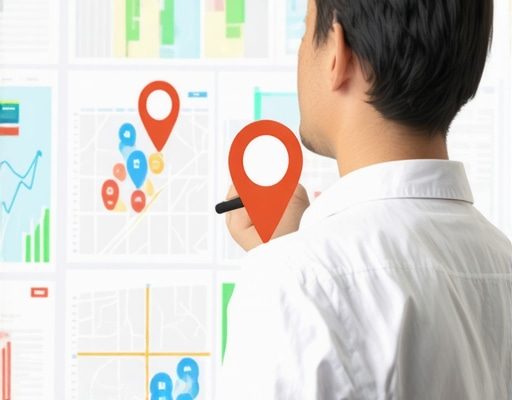
Boost Your GMB Click-Through Rate with Proven Maps SEO Tactics
My Journey into Maps SEO and GMB Success
When I first started optimizing my Google My Business (GMB) listing, I was overwhelmed by the sheer number of strategies available. I remember spending hours reading articles and experimenting with different tactics, trying to understand what truly made a difference in increasing click-through rates (CTR). Over time, I discovered that implementing proven Maps SEO tactics not only improved my visibility but also significantly boosted customer engagement.
Why Maps SEO is a Game-Changer for Local Businesses
In my experience, local SEO through Google Maps is one of the most effective ways to attract nearby customers. Google prioritizes local results, and optimizing your GMB profile ensures you appear at the top when potential clients search for your services. I found that focusing on local keywords and accurate business information created a stronger connection with my audience, leading to higher CTRs and more foot traffic.
My Proven Techniques for Elevating Your GMB Click-Through Rate
One tactic I swear by is regularly updating my GMB profile with fresh photos and posts. Google favors active listings, and engaging visuals catch users’ eyes. Additionally, I ensure my business categories and descriptions are optimized with relevant keywords, including local terms. For example, instead of just ‘plumber,’ I add ’emergency plumber in Downtown.’ This aligns with Google’s recommendation to use specific, relevant keywords for better rankings. For detailed strategies, I often refer to this comprehensive guide.
How Can I Keep Up with Maps SEO Changes?
What are the latest updates in Maps SEO that I should be aware of?
Google frequently updates its algorithms, and staying informed is crucial. I follow authoritative sources like Google’s official blog and industry experts to keep my strategies current. For instance, Google’s recent emphasis on local reviews has made reputation management more important than ever. By actively soliciting positive reviews and responding promptly, I’ve seen a tangible increase in my GMB engagement. You can explore more about this in this resource.
If you’re serious about boosting your GMB CTR, I recommend experimenting with different tactics and tracking your progress meticulously. Remember, what works for one business might not work for another, so personalization is key. Feel free to share your own experiences or ask questions in the comments below—I’d love to hear what’s worked for you!
What Are the Emerging Trends in Maps SEO That Can Boost Your GMB Engagement?
Staying ahead in the competitive landscape of local SEO requires an understanding of evolving Google Maps algorithms and best practices. Recent updates emphasize the importance of consistent NAP (Name, Address, Phone Number) data, enhanced review management, and multimedia integration. Incorporating Google Posts and regularly updating your profile with fresh photos can significantly influence ranking and CTR. For a comprehensive approach, explore this expert guide on Maps SEO strategies for 2025.
Reflecting on the Strategic Layers of Maps SEO
Over the years, my journey with Google Maps SEO has evolved from basic profile optimization to mastering complex, layered strategies that account for Google’s ever-changing algorithms. It’s one thing to optimize for today’s rankings, but quite another to understand the nuanced interplay between local signals, user behavior, and reputation management. For instance, I’ve realized that consistent NAP data isn’t just about accuracy; it’s about creating a reliable map of your business’s digital footprint that Google trusts implicitly. This trust translates into higher rankings and more sustained engagement, especially when combined with a strategic approach to reviews and multimedia updates.
The Complexity of User Intent and Engagement in Maps SEO
One aspect I’ve come to appreciate deeply is the importance of aligning your Google My Business content with the evolving intent of your local audience. It’s not enough to sprinkle keywords; you need to anticipate what your potential customers are truly seeking. For example, during a local event, I noticed a spike in searches for specific services related to the event itself. By updating my GMB profile and posts with relevant, timely information, I was able to capture this surge effectively. This approach underscores the importance of understanding local context and integrating it into your Maps SEO strategy to maximize CTR and engagement.
How Do Advanced Optimization Techniques Impact Long-Term GMB Success?
From my experience, employing advanced tactics like schema markup, local backlinks, and multimedia-rich profiles significantly enhances visibility. Schema markup, in particular, helps Google interpret your business details more precisely, which can lead to enhanced listings with rich snippets. I recall experimenting with structured data and seeing a noticeable uptick in profile impressions. However, these techniques require ongoing monitoring and refinement, as Google’s algorithms continually evolve. Staying ahead means continuously educating yourself through authoritative sources like this expert guide and adapting your strategies accordingly.
What Are the Hidden Opportunities in Maps SEO That Many Overlook?
One often overlooked avenue is community engagement through Google Posts and Q&A sections. I’ve found that regularly posting updates, special offers, or answering frequently asked questions can foster a sense of community and trust. These interactions not only improve your profile’s activity signals but also position your business as approachable and authoritative. Additionally, leveraging local collaborations—such as sponsoring community events or partnering with local influencers—can generate valuable backlinks and reviews, further boosting your Maps SEO efforts. To dive deeper into these strategies, explore this resource.
Ultimately, the key to sustained success in Maps SEO lies in a balanced approach—combining technical precision, local relevance, active user engagement, and continuous learning. I encourage you to reflect on your current strategies, experiment with new tactics, and share your experiences. The landscape is always shifting, but with a thoughtful, adaptive mindset, you can stay ahead and unlock the full potential of your GMB profile. If you’re interested in practical steps to elevate your engagement further, check out this comprehensive guide and let’s grow together!
Leveraging Local Schema Markup to Cement Your Digital Footprint
One of the most potent yet underutilized techniques in sophisticated Maps SEO is the implementation of local schema markup. By embedding structured data that clearly defines your business details—such as operational hours, service offerings, and geographical coordinates—you enhance Google’s understanding of your profile. This precision not only increases the likelihood of rich snippets appearing in search results but also fortifies your listing against competitors who neglect this layer of optimization. I recall integrating schema markup using Google’s recommended JSON-LD format, which resulted in a noticeable uptick in profile impressions and engagement. For a deep dive into effective schema practices, review this authoritative guide that has transformed my approach to local SEO.
What Role Do Hyper-Local Backlinks Play in Elevating Your GMB Authority?
While many focus on on-page elements and reviews, the strategic acquisition of hyper-local backlinks remains an underrated tactic. These links, sourced from neighborhood blogs, local news outlets, or community event pages, signal to Google that your business is an integral part of the local ecosystem. Building relationships with local influencers and participating in community initiatives can organically generate such backlinks. I’ve personally found that these backlinks not only improve rankings but also foster trust and credibility within the community, translating into higher CTRs. To explore effective methods for local backlink building, consider reading this comprehensive resource that offers actionable insights.
How Can Voice Search Optimization Transform Your Maps SEO Landscape?
With the proliferation of voice-activated devices, optimizing your GMB profile for voice search has become imperative. Voice queries tend to be more conversational and locally oriented, often including questions like “Where is the nearest coffee shop open now?” To capitalize on this trend, I recommend integrating long-tail, question-based keywords into your business descriptions and Google Posts. Additionally, ensuring your NAP data is consistent across all platforms enhances voice search accuracy. I’ve experimented with crafting FAQ sections tailored to common voice queries, which significantly increased my profile’s visibility in voice search results. For a detailed strategy, explore this expert guide on voice search optimization within local SEO.
Are You Harnessing the Power of User-Generated Content for Long-Term Success?
User-generated content (UGC), such as reviews, Q&A, and photos, is a dynamic asset that can exponentially boost your GMB engagement when strategically managed. I’ve found that actively encouraging customers to leave reviews, respond promptly to their feedback, and add photos leads to a vibrant, trustworthy profile. Moreover, UGC signals to Google that your listing is active and popular, which positively influences rankings. Implementing automated review request systems and engaging with community questions can sustain a continuous flow of fresh content. To deepen your understanding of UGC strategies, visit this resource that has significantly enhanced my approach to local visibility.
In the ever-evolving landscape of Maps SEO, the key to sustained success lies in a blend of technical mastery, community engagement, and anticipatory adaptations to emerging trends. I invite you to reflect on these advanced strategies and consider how they might be integrated into your ongoing optimization efforts. For personalized guidance or to share your experiences, don’t hesitate to reach out. Remember, the journey toward mastering local SEO is continuous—embrace the complexity, and you’ll unlock new levels of GMB engagement and business growth.
Things I Wish I Knew Earlier (or You Might Find Surprising)
1. The Power of Consistent NAP Data
Keeping your business name, address, and phone number consistent across all platforms isn’t just a technical detail—it’s the backbone of trust for Google. I once neglected this, and it cost me valuable rankings. Now, I double-check every listing to ensure uniformity, which has noticeably improved my local visibility.
2. The Underestimated Role of Community Engagement
Engaging with your local community through posts and reviews can boost your visibility more than many realize. I started actively responding to reviews and posting updates, and the positive impact on my CTR was remarkable. It’s about building trust and a sense of community.
3. Visual Content Is a Game Changer
Regularly updating your profile with fresh photos and videos has a surprisingly strong influence on rankings. I remember posting seasonal photos, which not only increased engagement but also helped keep my listing relevant in Google’s eyes.
4. Voice Search Is More Than a Trend
Optimizing for voice search by incorporating natural language and FAQs is something I overlooked initially. When I finally tailored my content for voice, I saw a significant uptick in local queries, especially during peak hours.
5. Structured Data Makes Your Profile Smarter
Implementing schema markup, especially local schema, helped Google understand my business better. This led to enhanced listings with rich snippets, which increased my profile impressions without extra effort on my part.
6. Local Backlinks Are More Valuable Than You Think
Building relationships with local blogs and news outlets has helped me gain backlinks that boost authority. It’s a slow process but yields long-term benefits that are worth the effort.
7. The Importance of Regular Profile Updates
Google favors active listings. I started scheduling weekly updates, which kept my profile fresh and improved my rankings. Even minor tweaks like updating hours or adding a new service can make a difference.
8. User-Generated Content Is a Trust Signal
Encouraging customers to leave reviews and add photos creates a lively profile that Google favors. I set up automated review requests, and the increase in UGC significantly boosted my local credibility and CTR.
9. Local Schema Is a Hidden Power
Adding local schema markup to my website helped Google better understand my business details, resulting in more prominent listings. It’s a technical step, but the payoff is well worth it.
10. Voice and Visual Search Are the Future
Optimizing for voice and visual search isn’t just for tech giants. Incorporating question-based keywords and high-quality images has helped me stay ahead of the curve, attracting more local traffic.
Resources I’ve Come to Trust Over Time
- Google’s Official Business Blog: Staying updated with Google’s own publications keeps me aligned with algorithm changes. It’s a reliable source I recommend to everyone.
- Moz’s Local SEO Guide: Moz has comprehensive, easy-to-understand resources that helped me grasp complex concepts quickly. It’s a go-to for strategic insights.
- Neil Patel’s SEO Blog: Neil Patel offers practical tips and case studies that I’ve found incredibly useful for real-world application.
Parting Thoughts from My Perspective
Reflecting on my journey with Maps SEO, I realize that the most impactful lessons revolve around consistency, community, and continuous learning. The landscape is always shifting, but staying proactive and adaptable has allowed me to maintain a strong GMB presence. If you’re serious about boosting your local engagement, start with the basics—like ensuring your NAP data is spot-on—and gradually incorporate advanced tactics like schema markup and local backlinks. Remember, the key is persistence and genuine engagement. If this resonated with you, I’d love to hear your thoughts. Feel free to share your experiences or ask questions in the comments below, and let’s grow our local visibility together!
You may also like

Boost GMB Click-Through Rates with Proven Maps SEO Tactics

Boost GMB Click-Through Rates with Proven Maps SEO Tactics

Reading through this post really resonated with my own experiences beginning with local SEO. I remember feeling overwhelmed by the various tactics and unsure which ones would truly make a difference. Over time, I found that consistent engagement, especially with reviews and community interactions, has a surprisingly strong impact on visibility and CTR. I also experimented with schema markup, and the results were quite noticeable, especially in terms of rich snippets. One thing I’d add is that tracking your progress and continually refining your strategy is crucial because Google’s algorithms are always evolving. Has anyone here tried optimizing for voice search yet? I’d be interested to hear how that’s been working for different types of businesses. It’s fascinating how voice and visual search are reshaping local SEO, and I’d love to explore more ways to leverage these emerging opportunities.